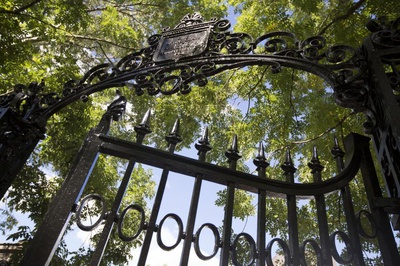
News
Harvard Grad Union Agrees To Bargain Without Ground Rules

News
Harvard Chabad Petitions to Change City Zoning Laws

News
Kestenbaum Files Opposition to Harvard’s Request for Documents

News
Harvard Agrees to a 1-Year $6 Million PILOT Agreement With the City of Cambridge

News
HUA Election Will Feature No Referenda or Survey Questions
It’s Time To Make Doubles a Thing of the Past
Mather House is a good house. Not great, but good.
From the outside, its architecture leaves much to be desired, and the trek to Harvard Square feels particularly punishing during the long New England winters. Yet despite these shortcomings, Mather offers something that makes it quietly enviable among Harvard’s undergraduate houses: Tons of single rooms.
Singles matter more than you think. Research consistently shows that a student’s academic performance and mood is tied to levels of clutter, noise, and light in their study environment — all of which improve dramatically when students have their own rooms. Although roommates can be great friends, they can also be huge distractions.
For an institution that charges over $75,000 per year in tuition and fees, a small private space for each student doesn’t seem like too much to ask.
Harvard clearly recognizes the need to improve student housing. The University is in the midst of a multi-year, billion-dollar House renewal project modernizing building systems and infrastructure across all twelve undergraduate Houses. Yet for all its ambition, this massive investment overlooks what could be the most significant improvement to students’ quality of life: increasing the number of single rooms available.
Harvard could increase the number of available singles in two ways. First, the University could add new structures to existing houses, either by converting buildings currently used for other purposes into student housing or by building more. For example, Harvard owns numerous properties in Mid-Cambridge and along Mt. Auburn Street that could be converted into House annexes.
The University has successfully employed this strategy before: The addition of Leverett Towers in 1960 nearly doubled that House’s capacity. Yet since Mather House and Currier House were added in 1970, Harvard has not significantly increased the housing space available for upperclassmen.
Second, Harvard could break up existing suites and convert them into singles. For example, 10 DeWolfe St., currently upperclassman overflow housing, primarily consists of apartment-style suites with double bedrooms. Students don’t need fully-furnished kitchens — much better to break apart the rooms into multiple singles. Even with more singles, there will still be plenty of common spaces where students can socialize.
Don’t get me wrong — I understand and value the role of roommates in college life, particularly during freshman year. Living with a randomly assigned roommate in Harvard Yard is a crucial part of the freshman experience. It teaches vital lessons in compromise, communication, and community living. Many students, myself included, forge lasting friendships with their freshman roommates.
But after that first year of shared living, the educational benefits diminish while the drawbacks multiply. Upperclassmen have already developed their social networks through classes, extracurriculars, and their blocking groups. They've mastered the basics of collegiate coexistence. What they need now is a space that supports their increasingly demanding academic and personal lives.
Consider this: Harvard Business School students live in singles. Harvard Law School students live in singles. Most graduate students across Harvard live in singles. The University clearly recognizes the value of personal space for serious academic work. Why shouldn’t undergraduates — who face similarly rigorous academic demands — have the same opportunity?
Mac M. Mertens ’26, a Crimson Editorial editor, is a double concentrator in Classics and History in Mather House.
Want to keep up with breaking news? Subscribe to our email newsletter.
From Our Advertisers

Over 300+ courses at prestigious colleges and universities in the US and UK are at your disposal.

With innovative financial tools combined with financial education, Collegiate empowers students to take control of their finances and build confidence in their money management skills.

Serve as a proctor for Harvard Summer School (HSS) students, either in the Secondary School Program (SSP), General Program (GP), or Pre-College Program.

With an increasingly competitive Law School admissions process, it's important to understand what makes an applicant stand out.

Welcome to your one-stop gifting destination for men and women—it's like your neighborhood holiday shop, but way cooler.

HUSL seeks to create and empower a community of students who are seeking pathways into the Sports Business Industry.

